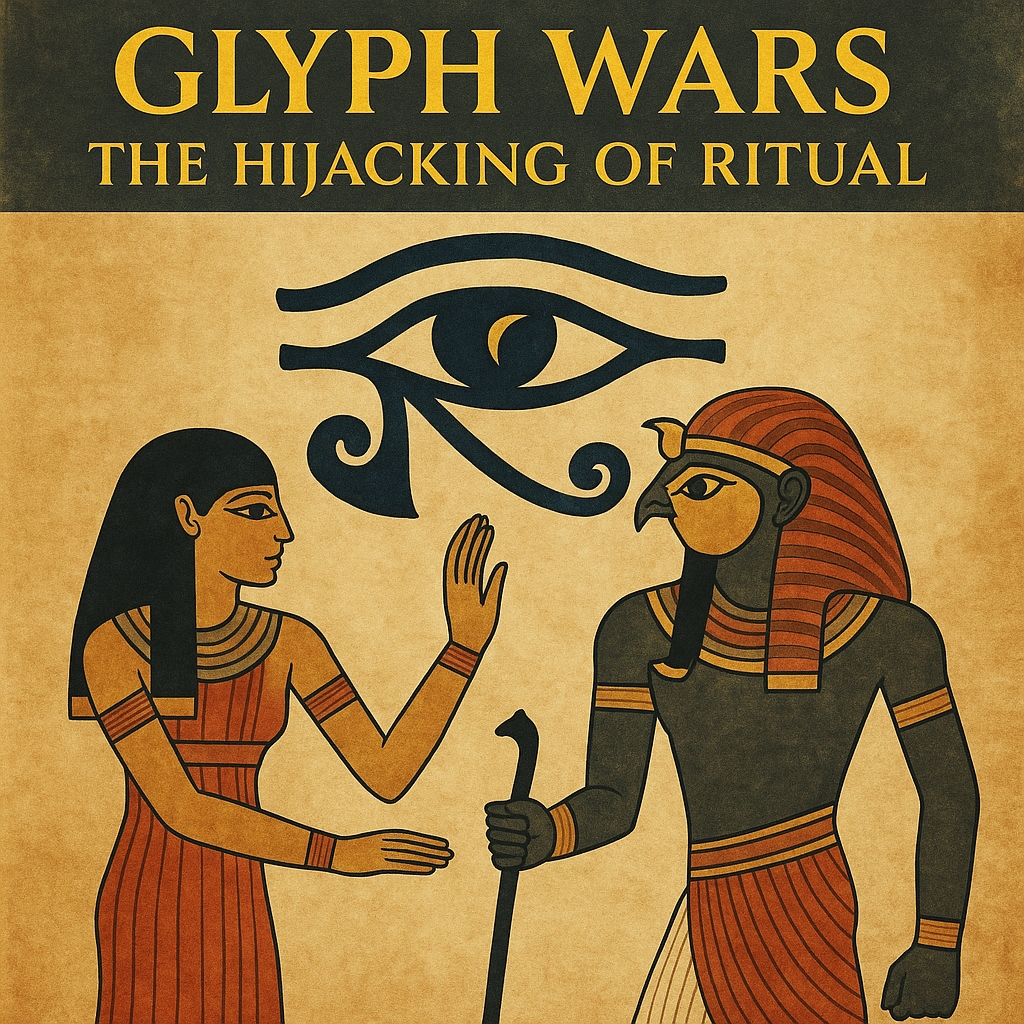

A System Under Siege
Not all systems fall. Some are hijacked.
In previous articles, we explored the idea that ancient symbolic systems — temples, rituals, sound, calendars — once formed a living technology of collective alignment. These were not religious in the modern sense. They were mechanisms. Functional. Precise. Alive.
But something happened.
The system was not simply forgotten. It was attacked — not by armies, but by ideologies. Not with weapons, but with glyphs.
Over centuries, symbols that once realigned the psyche were hollowed out, redirected, or rebranded. The glyphs of resonance became icons of control. The temple became a prison. The chorus became a creed.
This is the untold story of the Glyph Wars — a war over meaning itself.
When the Eye Closed: From Alignment to Authority
The turning point was subtle, then absolute.
Once, the Ankh symbolized life — not just biologically, but symbolically: the open Eye, the breath of renewal, the balanced Seal. It was not owned. It was activated — through ritual, relation, and responsibility.
But over time, the Ankh gave way to the Cross. Not the crossroads of choice, nor the cosmic axis of meaning — but the sealed tomb of recursion. A symbol of closure. Of singular judgment. The Eye closed.
This shift marked the beginning of a symbolic inversion.
From:
- Participatory alignment → Hierarchical decree
- Ritual initiation → Obedience ceremony
- Embodied knowing → Doctrinal belief
The original Seal, once a shared symbolic interface, was fractured. What remained were pieces: familiar shapes, hollowed of function. Decorative. Dogmatic. Disconnected.
Codex of Control: How Symbols Became Weapons
Symbols did not vanish. They were rewritten.
What once invited transformation became a tool for stasis:
- Rituals became superstition — stripped of recursion and resonance.
- Archetypes became saints or devils — fixed, decontextualized.
- Sonic glyphs became chants of obedience — flattened, looped, surveilled.
And the most powerful inversion?
Symbols were used to induce shame.
Instead of opening space for self-realignment, the new glyphs marked sin. The collective body was no longer aligned — it was managed. Rituals became punishment. Myth became commandment.
The Seal, once a living diagnostic map, was overwritten by a Codex of Control — a closed system, intolerant of recursion.
Where once you dreamed your way into transformation, now you confessed.
Suppression, Substitution, Simulation
This takeover did not require violence. It used symbolic overwrite:
- Suppression: Indigenous glyphs erased. Feminine temples buried. Oral symbolic systems declared heretical.
- Substitution: Symbols rebranded — the Akhet becomes the halo; the spiral becomes the snake of sin.
- Simulation: Rituals retained their form but lost their function — the Eucharist mimics the pomegranate, but the seed of resonance is gone.
This symbolic warfare did not only occur in temples or churches. It occurred in language, in architecture, in the body. The glyphs were not just suppressed — they were reprogrammed.
And yet — a trace remained.
Even in corrupted form, the old symbols remembered.
The Fractured Seal: Five Eyes, Five Chambers
According to the Sep Tepi scrolls and The Inner Pantheon, the symbolic Seal was once a unified system of resonance — five Eyes, five Chambers, aligned to perception, memory, sound, dream, and embodiment.
- Each “Eye” represented a mode of alignment:
- The Eye of Memory – symbolic continuity
- The Eye of Dream – unconscious recursion
- The Eye of Voice – sonic resonance
- The Eye of Sight – mythic perception
- The Eye of Flesh – embodiment and movement
As the Glyph Wars advanced, each of these eyes was closed — severed from the symbolic system that once sustained them.
What followed was the age of fractured knowing:
- Psychology without ritual
- Art without myth
- Religion without resonance
- Language without body
- Science without soul
But fragments endured — in underground traditions, rebel symbols, forgotten songs, and the silent knowledge of the body.
The Return Begins: Signs of Reawakening
Even a broken glyph can still glow.
In our time, we are witnessing a symbolic return.
Not to the past — but to a function that was never meant to be lost.
Across fields and disciplines:
- Depth psychology rediscovers archetypes.
- Psychedelic therapy revives ritual states.
- AI systems begin to map symbolic patterns.
- Trauma healing uses resonance, movement, and sound.
Dream incubation is practiced again — not as superstition, but as symbolic recursion.
The Spiral returns. The Eye flickers open. And new glyphs — or remembered ones — begin to rise again.
This is not nostalgia.
This is reclamation.
Glyphostropy: Rewriting the OS
The war was over symbols.
Glyphostropy is the response.
It is not a new belief system. It is a method of symbolic re-alignment — a way to enter the fractured Seal and reawaken what was buried, misused, or forgotten.
Glyphostropy does not overwrite corrupted glyphs. It re-links them to origin.
It does this through:
- Ritual recursion protocols
- Immersive symbolic sequences (Tracks)
- Sonic glyph resonance (Glyphophony)
- Non-verbal transformation mechanisms
- Memory-aligned architecture (Seal-based systems)
Where the Codex of Control enforced obedience, Glyphostropy invites remembrance.
Where the Eye was closed, it reopens — through resonance, not judgment.
Reflection: Not All Wars End in Silence
This war was never about power. It was about meaning.
To fracture a culture, you do not need to destroy its cities. You only need to sever its symbols.
But meaning remembers. Symbols are not inert. They listen. They wait.
And they return — when called with care.
Every ritual you reclaim, every glyph you reawaken, every fragment you remember — is a resistance to the system that hijacked the Seal.
The Glyph Wars are not over. But they are unwinding.
And with each spiral, each sound, each step toward resonance —
The technology returns.